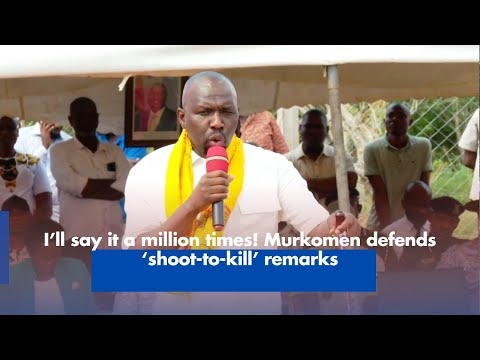Former Gatanga MP Peter Kenneth is steadily becoming the preferred running mate for ODM leader Raila Odinga, who is seeking the presidency for the fifth time.
According to two separate opinion polls released in February, support for Kenneth is so high that the second preferred choice of running mate for Raila trails him in double digits.
This is quite a feat given that Kenneth vied for Nairobi governor in 2017 as an independent candidate. He does not lead any political party and has not held an elective office since 2013.
Those who trail him in the polls have a higher national profile than he does and lead their own parties. Others hold elective office or serve in the Cabinet.
The Radio Africa Group poll released on February 17 showed 36.6 per cent of respondents said Kenneth was their preferred choice as running mate for Raila. This was 26 per cent points above the second preferred choice, Kalonzo Musyoka, who got 10.5 per cent. Kalonzo was Raila’s running mate in the 2013 and 2017 general elections.
Narc-Kenya leader Martha Karua was third with 9.8 per cent.
In a separate opinion by Trends and Insight for Africa also released on February 17, respondents were asked who among the possible running mates they thought would be best for getting the most additional votes for Raila.
For 41 per cent of the respondents, it was Kenneth, while Kalonzo came in second with 18 per cent. Karua was third with 13 per cent.
TIFA did not ask this question in their December poll, but in the Radio Africa Group poll released on January 19, Kenneth led as the preferred running mate for Raila among the respondents. Kenneth got 27.3 per cent.
In second place was Kalonzo with 13.2 per cent, while ANC leader Musalia Mudavadi was third with 12.1 per cent. Karua was fourth with 10.6 per cent.
From the two Radio Africa Group polls, it is clear more respondents see Kenneth as their preferred running mate for Raila. Between the January and February polls, Kenneth gained about nine percentage points in support, from 27.3 per cent to 36.6 per cent.
This is partly explained by Mudavadi forming an alliance with Raila’s rival, Deputy President William Ruto, in late January, there by removing him from consideration as a potential running mate for the ODM leader.
But Kenneth has not just gained more support because Mudavadi is out of the equation. His gain also seems to be because Kalonzo and Karua have lost support.
The Wiper leader's support dipped to 10.5 per cent in February, from 13.2 per cent in January, while Karua’s also dropped to 9.8 per cent in February, from 10.6 per cent in January.
Kenneth has achieved this rise in the polls without being a party leader like Kalonzo and Karua are or having a political party backing his candidacy.
He, therefore, does not have other politicians and their supporters talking up his potential as a running mate. So why is Kenneth leading?
His positioning as an independent politician has helped. As an independent, Kenneth is not tied to a party and has avoided the pull and push of party politics. This has freed him to attend many of Raila’s functions and speak. This has raised his visibility and allowed potential voters to see how he and Raila may look as a campaigning duo.
In comparison, Kalonzo and Karua have only appeared at a handful of political functions where Raila has also been present. The Wiper leader has also been under pressure from his party to remain committed to being a presidential candidate. He has also been working to unite the One Kenya Alliance, of which his Wiper party is a member. Kalonzo has also worked at persuading Karua to join the alliance.
Kenneth positioning himself as an independent has allowed him to avoid the intra-party fight for dominance in Mt Kenya. He has identified himself as clearly part of the Azimio La Umoja Movement that Raila is forging together.
But Kenneth is not a member of any of the Azimio-affiliated parties seeking to garner the most governors, parliamentary and county assembly seats in Mt Kenya. This has allowed him the flexibility to appeal for the Mt Kenya vote for Raila without having to balance that appeal with a particular party’s interests in the region.
According to political pundits, the Mt Kenya vote is the key to winning the August presidential election because the region has a huge number of voters and none of the aspiring presidential candidates from the region are seen to be able to win them.
This means the Mt Kenya vote is up for grabs and the presidential candidate who can garner a significant percentage of it increases their chance of winning. The conventional wisdom also is for that to happen, a presidential candidate will need a running mate from the region.
This is where Kenneth comes in. And this is why being an independent helps him. But the polls tell another story.
Kenneth is not a leading potential candidate for running mate for Raila because he has overwhelming support in the Mt Kenya region. His support in other regions is much higher than the support he has in Central.
According to the TIFA poll, Kenneth’s support in Mt Kenya stands at 35 per cent. This is the highest of any of the potential candidates for running mate. However, Kenneth’s support in Central Rift, Nairobi, South Rift and Nyanza is above 50 per cent.
In Central Rift, he has 51 per cent support, 53 per cent in Nairobi, 59 per cent in South Rift and 50 per cent in Nyanza. This means Kenneth has stronger support as a running mate outside Mt Kenya.
The tepid support the polls show he has in Mt Kenya is not Kenneth’s only concern. His chance of being Raila’s running mate will also be determined by what happens in the Azimio la Umoja.
By the end of February, the alliance was supposed to be have been firmed up. That did not happen. There are still many moving parts in the coalition and it is unclear how that will affect Raila’s choice of running mate.
Journalist, International Justice Monitor
(Edited by V,Graham)
WATCH: The latest videos from the Star









![[PHOTOS] Boniface Kariuki honoured with flag-draped coffin](/_next/image?url=https%3A%2F%2Fcdn.radioafrica.digital%2Fimage%2F2025%2F07%2Fc7df13cc-0b58-4ec7-b6a4-7e32e1d9ec63.jpg&w=3840&q=100)
